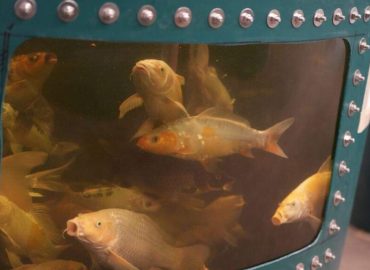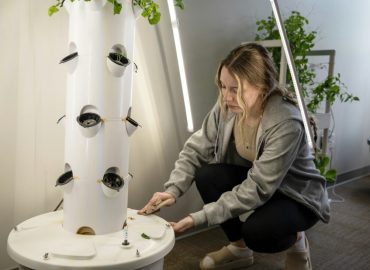Forever Green Farms California
New $240,000 grant aims to revolutionize agriculture in California’s Imperial Valley
Forever Green Farms California | Jessamyn Dodd |
IMG: Water drips from plants at Bolton Farms, a hydroponic farm, on Saturday, March 22, 2025, in Hilton, N.Y.AP PHOTO
CALIPATRIA — A bold new agricultural initiative is taking shape in Calipatria. The Becoming Project, Inc. has been awarded a $240,000 planning grant through the California Jobs First Initiative to launch Forever Green Farms, a hydroponics and aquaponics site that promises to deliver food, jobs, and training to one of California’s most economically challenged regions.
The farm is a joint effort between The Becoming Project, Inc., and community leader William Cooper, who brings his experience to the project.
“I am currently a sector lead for Disinvested Communities for the California Job Search Initiative. It is a partnership with the governor’s office to do job creation and lower emissions in the period,” Cooper said in an in-depth interview with the Imperial Valley Press.
With Imperial County’s high unemployment rate hovering near 16%, Cooper hopes to transform the agricultural workforce through training and sustainable practices. He warns of trends of Artificial Intelligence and machinery replacing humans in the sector, stating, ”The current farm industry or the farm worker industry, the way that we know it, is being rapidly eliminated by ag technology and machinery. So the current workforce will be eliminated in the next 15 to 30 years.”
“You see that right now the fieldwork—I don’t know if you know—all the work is going to Arizona, to Yuma. There are not so many vegetables here in the Valley due to water issues,” added Ruben Partida, Executive Director of Comité de Acción del Valle. He noted the difficulty agricultural workers have working in the high temperatures in Imperial Valley. Hydroponic systems can utilize significantly less water compared to traditional methods (60-90% less). This is a major advantage in the Imperial Valley, where water resources are a critical issue.
For Cooper, it makes sense to train people who are already familiar with farming. Partida confirmed, “So we wanted to do this initiative to be able to make the transition… so that these workers have work throughout the year.’
The hydroponic site will feature indoor grow houses, solar power, and an aquaponics system with catfish and tilapia. Its closed-loop water system, Cooper said, is vital in Imperial County, where high water costs and drought conditions have strained traditional agriculture.
The initial grant only covers planning and permitting; additional funding will be required to build the site. Still, Cooper is optimistic.
“We will have to find other sources to do the actual building of this project, but it is a sound idea with community support and seemingly support by the governor’s office. So the best thing we can do right now is set the foundation.”
Construction may take place on donated land, thanks to a partner with an existing traditional grow house, which will be used for seed propagation before operations move to the new site.
“One of our partners is a landowner in Imperial County, so he’s graciously given us the green light to use his property,” Cooper divulged.
Forever Green Farms will prioritize high-yield crops such as lettuce, kale, strawberries, and tropical fruits.
Cooper explains, “And then at the bottom, catfish and tilapia are the two things that we’re primarily looking at now.”
Partida explained the reasoning behind the tilapia farm. “Because it is more commercial,” he said, suggesting that tilapia is easy to raise.
“We are also going to have people who are going to be processing the product, the fish, to pack it so that it is ready for the market,” he said.
The aquaponics system will function as a small ecosystem, where waste from the fish nourishes the crops, and in turn, the plant’s roots feed the fish. Filtration systems will be installed to ensure the water remains clean.
Community engagement
In addition to jobs, the program emphasizes education and inclusivity. Cooper said the project will include biweekly community assessments, entrance exams, tutoring, and regular evaluations to ensure participants stay on track.
“It’s not just the training that comes with growing and building the structure. It’s to make sure that a person can rewrite and comprehend the material before we get started. That’s what sets this process apart from other processes.”
A group of 25 workers will begin paid training at $25 an hour starting in July.
Partida noted, “They will be trained in electricity and how they can work in applying solar panels; everything they need to be able to lift their lives.”
The team has also reached out to UC Davis, one of the leading schools in sustainable agriculture, hoping to partner with them. Imperial Valley College has also been contacted, though Cooper is still waiting for a response.
The UC Agriculture and Natural Resources Desert Research & Extension Center implemented a hydroponic greenhouse project for tomato and lettuce production, also involving community and school funding.
Commitment to equity
The project’s commitment to equity is clear: 60% of the produce and resources from the farm will go directly back to the community, rather than be shipped out of the county and state.
“Right now, California has the 40 for 40 program that says that 40% of any development in the community ought to benefit the community. This project was automatically starting at 60%,” said Cooper.
“60% of any produce, crops, or any resource that came from the production of this development will automatically go back to the community. We will also have an independent community system set up to assure that the disbursement goes to the people that need it most.”
The mission
The Becoming Project, which began in San Diego, focuses on “equity, awareness, advocacy and education in disadvantaged communities.” Of 99 applicants to the California Jobs First Initiative, only 19 projects were selected to receive funding. Forever Green Farms made the cut.
‘This was a competitive process,” Cooper said.
With planning underway through September, the next milestone will be the implementation phase and securing construction funds. Looking ahead, Cooper said, “That’s another granting process, but it also requires another proposal and another application.”
As Cooper put it, the ultimate goal is simple but urgent: “How do we feed the people when nobody else can feed the people?”
The post Forever Green Farms California appeared first on GROZINE.



